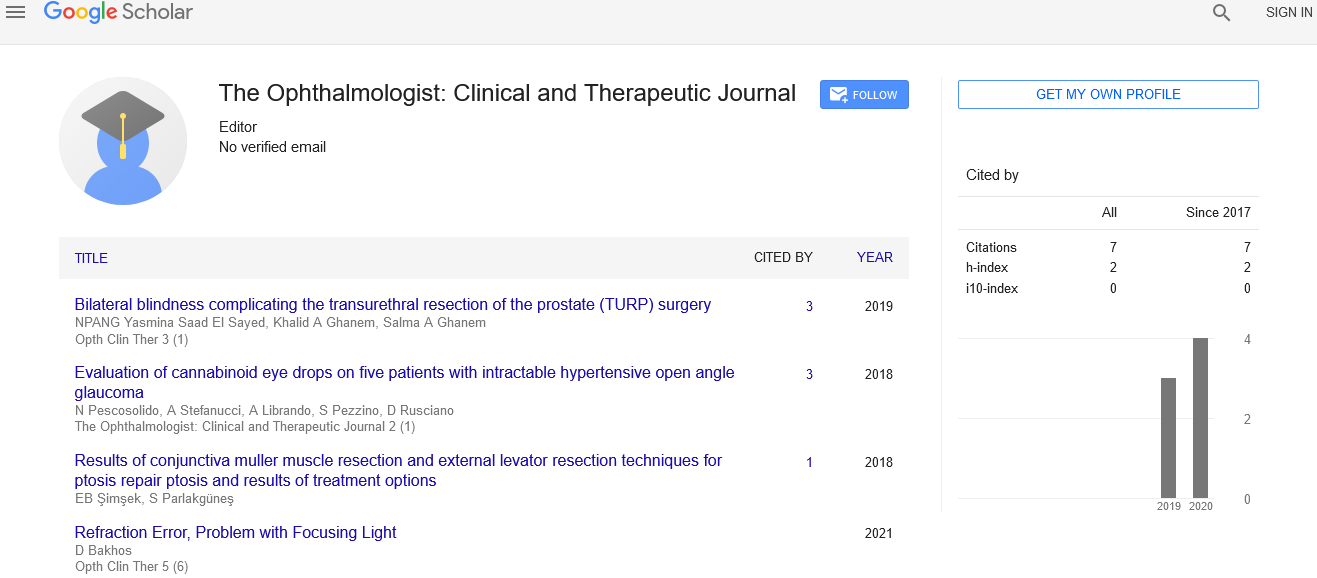Fighting photoreceptor degenerative eye diseases by addressing primary cilia dysfunction
Received: 16-Oct-2023, Manuscript No. PULOCTJ-23-6801; Editor assigned: 18-Oct-2023, Pre QC No. PULOCTJ-23-6801 (PQ); Reviewed: 02-Nov-2023 QC No. PULOCTJ-23-6801; Revised: 17-Jan-2024, Manuscript No. PULOCTJ-23-6801 (R); Published: 24-Jan-2024
Citation: Jaun S. Fighting photoreceptor degenerative eye diseases by addressing primary cilia dysfunction. Opth Clin Ther. 2024;8(1):1-2.
This open-access article is distributed under the terms of the Creative Commons Attribution Non-Commercial License (CC BY-NC) (http://creativecommons.org/licenses/by-nc/4.0/), which permits reuse, distribution and reproduction of the article, provided that the original work is properly cited and the reuse is restricted to noncommercial purposes. For commercial reuse, contact reprints@pulsus.com
Abstract
Photoreceptor degenerative eye diseases pose a significant threat to vision and quality of life. Primary cilia dysfunction has been increasingly implicated in the pathogenesis of these diseases. This research article explores the role of primary cilia dysfunction in photoreceptor degenerative eye diseases and discusses potential therapeutic strategies to target primary cilia for disease intervention.
Keywords
Photoreceptor degenerative eye diseases; Primary cilia; Ciliopathies; Retinal degeneration; Therapeutic strategies
Introduction
Photoreceptor degenerative eye diseases, including retinitis pigmentosa and age-related macular degeneration, are characterized by progressive loss of photoreceptor cells in the retina, leading to severe vision impairment and ultimately blindness. Primary cilia, small hair-like structures found on the surface of most eukaryotic cells, have emerged as crucial regulators of various cellular processes, including photoreceptor function and health.
Primary cilia play a vital role in photoreceptor signaling, maintenance, and development. Dysfunction of primary cilia, known as ciliopathies, has been linked to a range of genetic disorders, including some forms of retinal degeneration. Research has indicated that defects in primary cilia can disrupt critical signaling pathways in photoreceptor cells, contributing to the onset and progression of degenerative eye diseases.
Understanding the relationship between primary cilia dysfunction and photoreceptor degenerative eye diseases is essential for the development of targeted therapeutic approaches to mitigate vision loss and improve the lives of affected individuals.
Description
This article aims to explore the role of primary cilia in photoreceptor degeneration and discuss potential strategies for addressing primary cilia dysfunction as a means to combat these debilitating eye diseases.
Primary cilia dysfunction in photoreceptor degenerative eye diseases: Primary cilia dysfunction can result from genetic mutations, environmental factors, or a combination of both. In the context of photoreceptor degenerative eye diseases, impaired primary cilia function disrupts essential signaling pathways, such as the Hedgehog and Wnt signaling pathways, which are crucial for photoreceptor development, maintenance, and survival.
Recent studies have identified specific genes associated with primary cilia dysfunction that play a role in photoreceptor degeneration. For instance, mutations in genes encoding proteins involved in cilia structure and function, such as RPGR and RP1, have been linked to retinitis pigmentosa. Understanding these genetic and molecular mechanisms can guide the development of targeted therapies aimed at restoring primary cilia function and ultimately preserving vision in affected individuals.
Photoreceptor degenerative eye diseases, including retinitis pigmentosa and age-related macular degeneration, significantly threaten vision and quality of life due to the progressive loss of photoreceptor cells in the retina. These conditions ultimately lead to severe vision impairment and blindness, highlighting the urgent need for effective therapeutic interventions. Recent research has increasingly implicated primary cilia dysfunction in the pathogenesis of these diseases. Primary cilia, small hair-like structures present on the surface of most eukaryotic cells, play a vital role in regulating various cellular processes essential for photoreceptor health and function. They are critical for signaling, maintenance, and development of photoreceptors. Dysfunction of primary cilia, referred to as ciliopathies, has been linked to several genetic disorders, including various forms of retinal degeneration.
Understanding the intricate relationship between primary cilia dysfunction and photoreceptor degenerative eye diseases is crucial for developing targeted therapeutic strategies to mitigate vision loss. Impaired primary cilia function disrupts essential signaling pathways, such as the Hedgehog and Wnt pathways, which are integral to photoreceptor development, maintenance, and survival. Recent studies have identified specific genetic mutations associated with primary cilia dysfunction that contribute to photoreceptor degeneration. For example, mutations in genes encoding proteins involved in cilia structure and function, such as RPGR and RP1, have been closely linked to retinitis pigmentosa. These findings underscore the importance of elucidating the genetic and molecular mechanisms underlying primary cilia dysfunction, as they can inform the development of targeted therapies aimed at restoring ciliary function and preserving vision in affected individuals.
Furthermore, potential therapeutic strategies may involve gene therapy to correct mutations affecting primary cilia function or small molecules designed to enhance ciliary signaling pathways. Additionally, advancements in stem cell technology may allow for the regeneration of photoreceptor cells or the restoration of ciliary function in degenerating retinas. Collaborative efforts between geneticists, molecular biologists, and clinicians are essential to translate these findings into viable treatments.
Conclusion
In conclusion, primary cilia dysfunction represents a critical factor in the pathogenesis of photoreceptor degenerative eye diseases. Targeting these cilia to restore their function and mitigate disruptions in critical signaling pathways holds promise as a novel therapeutic strategy. Future research and clinical initiatives should prioritize developing interventions that directly address primary cilia dysfunction, aiming to slow or halt the progression of these debilitating eye diseases and significantly improve the quality of life for affected individuals. By enhancing our understanding of primary cilia's role in retinal health, we may unlock new avenues for intervention and pave the way for innovative therapies that can preserve vision in those impacted by these challenging conditions.
Primary cilia dysfunction represents a critical factor in the pathogenesis of photoreceptor degenerative eye diseases. Targeting primary cilia to restore their function and mitigate the disruptions in critical signaling pathways holds promise as a potential therapeutic strategy. Future research and clinical efforts should focus on developing interventions that address primary cilia dysfunction, aiming to slow down or halt the progression of these debilitating eye diseases and improve the quality of life for affected individuals.





